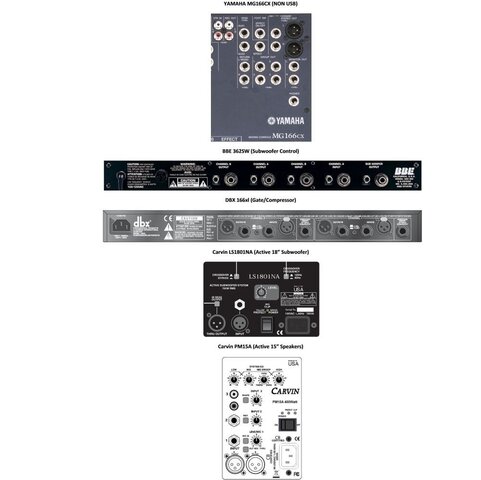Gain structure is a very finicky thing to try and diagnose on the internet.
And even more challenging when there is no
manual or specs for the
subwoofer and the online mains
speaker '
manual' is more a sales sheet that doesn't identify what the
clip light is actually showing or what input levels the
speaker handles. Not that I'd trust info from a manufacturer that lists a 700W continuous and 1,400W peak
power rating or that and a 4
Ohm impedance as relevant, much less the only, specs for a powered
speaker.
Anyways, I can find the nominal or peak input and output levels for the other devices but without knowing what the speakers handle that does make the problem difficult to diagnose without being there. It also makes it difficult to suggest how to configure the
comp/
limiter, but if you are using it for peak limiting and it is set properly then you should not be seeing more than intermittent peaking, if any, at the speakers.
The mains and the sub both seem to be peaking with the above set up. Any clues as to what to lower from the input so we can get a better max output? Unable to put the volume past 12:00 on any speakers.
Can you clarify the setup? You have a two
channel mixer and two
channel processors, one of which also provides a
mono subwoofer output. You also apparently have a single powered sub that has the option for a high pass output and two powered mains. I'm not
clear on whether you are using the BBE or not or on how you have everything wired between devices.
Of course there may also be a simple factor of whether you should expect to be able to turn the input past 12:00 or expect to get more output. The input
level control is not adjusting the
amplifier, it is adjusting the signal going to a fixed
gain amplifier. If the
speaker is
clipping then the input signal
level is probably at or past the maximum the
speaker input or internal
amplifier supports and you may already be getting the maximum output. Depending on the
level the
speaker input is intended to take versus that the other equipment can deliver, it would not be unusual to not be able to run the input at full volume.
Just for an example, I looked at some of the Carvin amplifiers and they all have a specified sensitivity of 1.0V. The sensitivity for an
amplifier is the input
level that will produce full output and input levels greater than that provide no benefit in terms of output and typically need to be attenuated. 1.0V is about 2.2dBu, so there is a reasonable chance that the powered speakers will provide full output with somewhere around a 2.2dBu input
level. In comparison, the
mixer, BBE and
comp/
limiter all support +20dBu to +24dBu input and output signal levels. Thus if the
clip light is reflecting the amp input or output
clipping then it would not be surprising to see proper
gain structure result in around 20dB of attenuation being required at the powered
speaker inputs, which could explain why you can't turn up the input past 12:00 without getting
clipping. That may not indicate anything wrong other than your trying to get more from the speakers than they can support. And that is why this can be so tricky, depending on the levels through the rest of the
system, what you're seeing may be normal or not.




